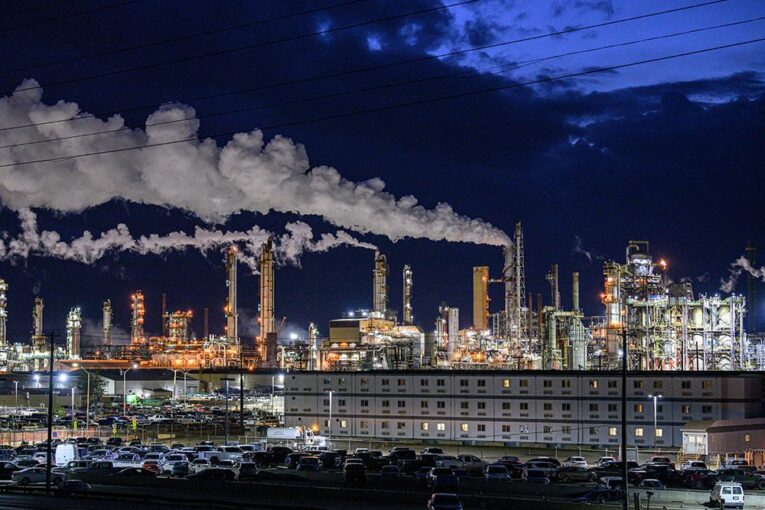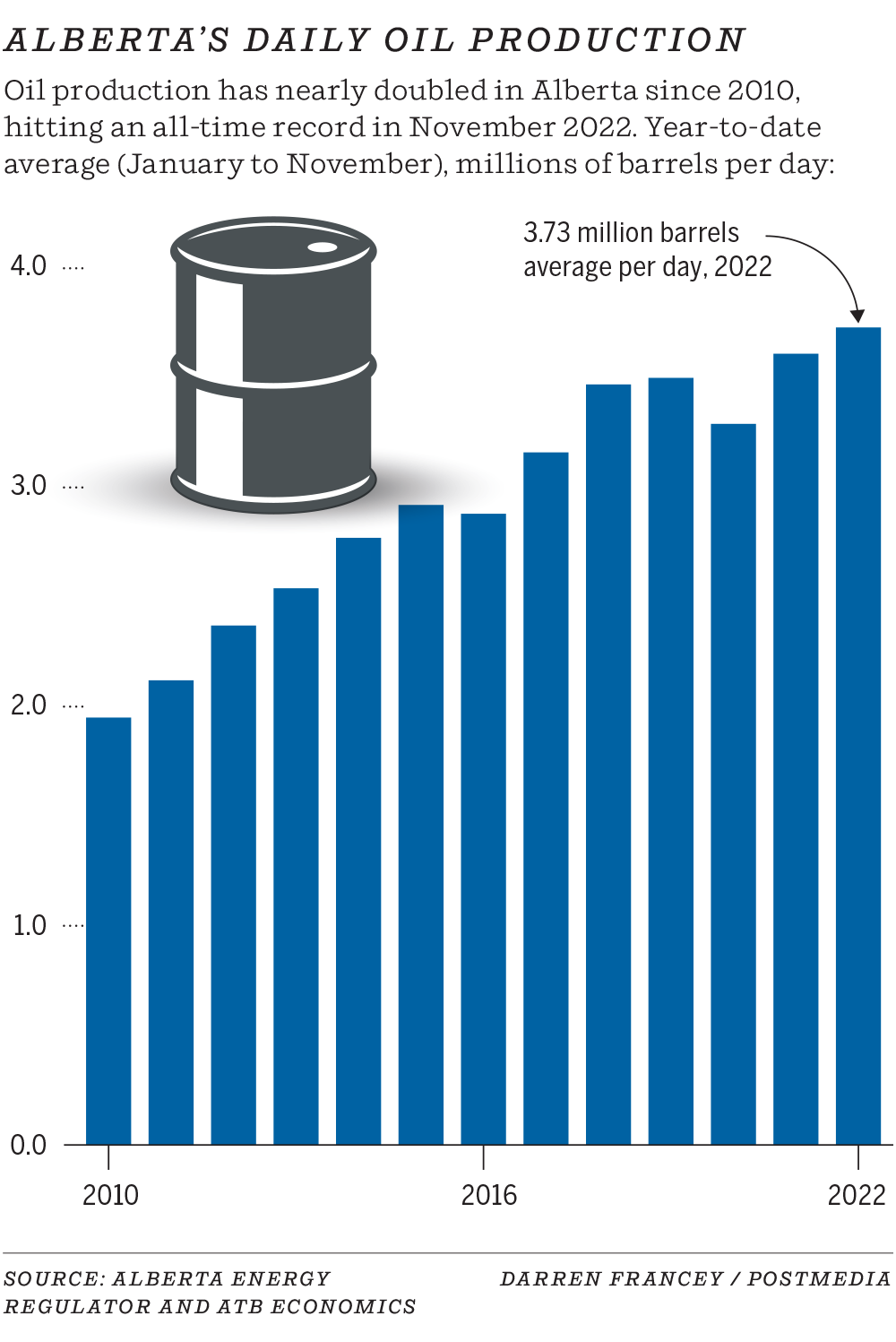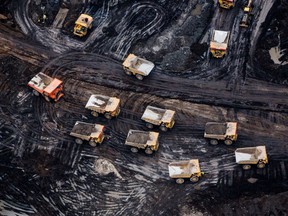
Alberta posted an oil production record in November by pumping out almost four million barrels per day, but Premier Danielle Smith warns the incoming federal cap on oil and gas emissions could lead to provincial crude being shut in — a lot of it.
The number, she suggested this week, could potentially reach two million barrels per day.
Critics question the size of such an eye-popping figure, while the provincial Environment Department said Friday that the number was “prematurely provided to her.”
But the premier’s contention that some oil and gas production would be shut in strikes at the heart of Alberta’s dispute with a federal plan to restrict oilpatch greenhouse gases. With a mandate to cut emissions 42 per cent by 2030, the province fears it will effectively become a production cap.
If that’s the case, it would trigger a legal showdown with the feds over Alberta’s constitutional authority surrounding natural resource development.
“It would shut in our oil, I’m told as much as two million barrels, which is about half our production,” Smith said on a weekend radio program.
“Just do the math on that — half of all the jobs that are in the sector, half of all our royalties that are in the sector, billions of dollars.”
Analysts want to see the modelling that indicates production losses could be that large and what assumptions are included in the scenarios.
The provincial Environment Department did not make any assessments available this week, but government officials issued a statement Friday about the two million bpd figure, saying it’s “unable to confirm the data at this time.”
“I don’t think it is plausible,” University of Alberta energy economist Andrew Leach said Thursday.
“I’m not disputing the idea there are projects that might not be viable under different emissions policies … but two million barrels per day is a really big number.”

Industry groups are keeping a close eye on the broader issue, including the federal government’s development of the emissions cap — which could kick in as early as next year — and what it will mean for expanding oil and gas production in the province.
“There is a possibility or a risk the emissions cap could lead to decreased growth, as well as even the potential shutting-in of production,” said Tristan Goodman, president of the Explorers and Producers Association of Canada.
In a written submission to the federal government, the Canadian Association of Petroleum Producers said analysis by Navius Research shows the emissions cap would result in oil production being reduced by more than 600,000 barrels bpd, and natural gas by two billion cubic feet per day by 2030, when compared with a reference case scenario.
Officials with CAPP said they’re completing additional analysis, but aren’t yet able to share it.
Canada’s oil and gas sector is the largest emitting industry in the country and federal pressure has been growing on companies to spend money to decarbonize as the government has adopted a net-zero goal by 2050.
Six of the largest oilsands operators in the country formed the Pathways Alliance in 2021 and are collaborating to reach net-zero. Their plans include developing a $16.5-billion carbon capture, utilization and storage network in the province, and using other technology to lower emissions.
Recommended from Editorial
-

Oilpatch concerned that federal emissions cap could require production cuts
-

Varcoe: Canada can hike oil output and decarbonize — ‘but at significant cost,’ says RBC report
-

Danielle Smith says Alberta is tired of being Ottawa’s ‘punching bag,’ but will consider carbon capture aid
-
‘We’ll go to the wall for you’: Alberta premier makes defiant speech to energy producers
-

Varcoe: As oil prices soar, Alberta’s energy production to jump by 52% in 2022
In an interview this week, Smith said oilsands companies can’t reach the interim federal target for 2030, given the time it will take to complete the CCUS hub or develop other initiatives.
“If you end up having an emissions cap that is too short a timeframe and the technology is not available to roll out, it acts as a de facto production cap … The environment ministry, they suggest it might be as high as two million barrels a day and that’s clearly offside with the Constitution,” she said.
“I don’t want to get hung up on the amount … but the point of fact that I’m making is the technology isn’t available by 2030 to achieve a 42 per cent emissions reduction without them implying there’s going to be (oil) shut in.”

The Pathways Alliance have said they’re working on a strategy to lower emissions by 22 megatonnes by 2030, which amounts to about a 27 per cent decline.
With only seven years to reach the federal goal, it will require a massive amount of engineering work, time-consuming regulatory approvals and construction in major decarbonization projects to reach the target.
“There is a physical speed limit to which you can build out large industrial-scale decarbonization technologies like CCUS,” said analyst Kevin Birn, vice-president with S&P Commodity Insights.
Federal Environment Minister Steven Guilbeault wasn’t available for an interview this week.
A statement from his office noted pre-consultations on the oilpatch emissions limit have wrapped up regarding two different options for the program’s design: increasing the carbon price that is applied to the sector or adopting a cap-and-trade system.
“It’s important to recognize that emissions reductions are possible and aligned with industry’s stated goals, without cuts in production,” it said.
Alberta Environment Minister Sonya Savage said the provincial government is completing its own analysis of the implications of the emissions cap and 2030 target.
However, she pointed out the federal government’s emissions reduction plan released last spring uses economic modelling that shows oilsands production could fall by 10 per cent by 2030.
“We are still working on some modelling and some numbers, but there is no question that it’s a significant cut in production, even with the federal government’s own numbers, and that’s why we’re so concerned about it,” Savage said.
What happens if production needs to be shut in to meet Ottawa’s goal?
The premier stressed it would be offside with Section 92-A of the Constitution, which states provinces can exclusively make laws related to exploration, development and management of non-renewable natural resources.
“We’ll be prepared to fight that out,” Smith said.
Leach, who recently co-authored a paper on Section 92-A of the Constitution, doesn’t agree the matter is a slam dunk.
However, he also believes it’s a “challenging question” and the courts would need to determine if the federal government is overstepping its authority.
“I would be surprised if it weren’t challenged.”
Chris Varcoe is a Calgary Herald columnist.
You can read more of the news on source
